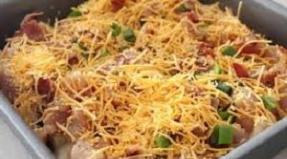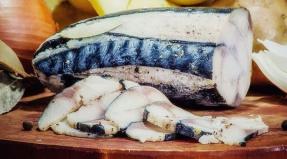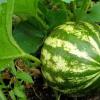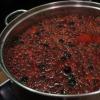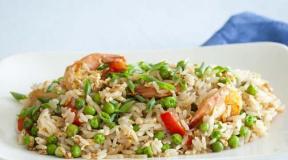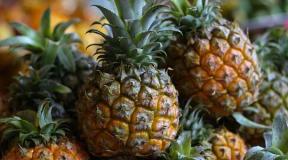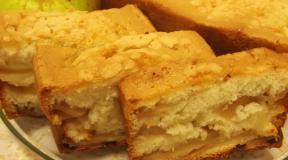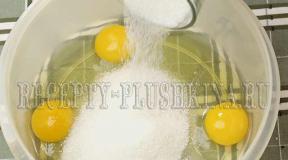Canning mini factories, workshops. Canned food production
When preparing fruits and vegetables for processing, there are many general operations that do not depend on the type of product being produced.
Inspection and sorting. To remove defective specimens and impurities, the raw materials are inspected. Then it is graded to be sorted according to the degree of maturity, color, spotting, burns and to obtain homogeneous batches according to these characteristics.
Calibration. It is carried out to obtain batches of raw materials, uniform in size, which is important in the production of pickled vegetables, compotes, jams and some other canned food.
Washing is one of the most important operations. Its purpose is to remove mechanical impurities, microorganisms and chemicals from the surface of raw materials. Most often, washing is carried out in two stages: at the beginning of the technological process (then it is better to view the fruits and vegetables during sorting) and after sorting.
Cleaning. It is carried out to remove inedible or nutritionally low-value parts of fruits and vegetables: leaves, peels, sepals, stalks, etc.
Root crops, onions and fruits are mechanically cleaned in special machines. Peaches are peeled by boiling. Certain types of raw materials are thermally cleaned.
Chopping and cutting. To destroy tissues, raw materials are crushed by crushing or cutting. Grinding increases the juice yield. Cutting is also the grinding of fruits and vegetables in order to give them a certain shape and size.
Heat treatment. Certain types of raw materials are first subjected to heat treatment, and then packaged in containers. Blanching is carried out by short-term heat treatment of raw materials in boiling water, steam or in aqueous solutions of salt, sugar, organic acids or alkalis. As a result, enzymes are destroyed, peeling of the skin is facilitated, microorganisms are destroyed, proteins are coagulated, protoplasm of cells increases (this makes it easier to extract juice), the elasticity of raw materials increases (it is easier to put it in jars). The appearance of cracks on the surface of the berries improves the cooking of the jam - the sugar penetrates into the berries faster.
Packing. Prepared fruits and vegetables are packed in carefully washed containers using automatic fillers of various systems. At the same time, make sure that there are no deviations from the recipe in terms of the ratio of the constituent parts of canned food (for example, berries and syrups in compotes).
Exhausting. When packing in cans, air enters together with the raw material, the oxygen of which contributes to the oxidation of various substances in the products, increases the corrosion of sheet metal in areas poorly coated with varnish or tin. Therefore, it is advisable to remove air from the cans when sealing. The operation to remove air from cans is called deaeration. It is carried out by pre-heating products or by sealing in automatic vacuum-sealing machines.
Capping. Glass jars are sealed with metal lids with rubber rings or paste.
Sterilization (pasteurization). This is the most important operation in the preparation of hermetically sealed canned food. The sterilization regime depends on the type of product, size and type of container. In an acidic environment, microbes die faster than in a neutral one; juices and puree foods heat up faster than canned foods made from solid foods, etc. In this regard, for each type of canned food and containers, its own modes of sterilization and pasteurization have been developed. Canned food is sterilized and pasteurized in vertical and horizontal batch autoclaves.
The production of various types of canned products is possible from the same batch of raw materials.
Tomato is the most important canned vegetable crop. Its fruits contain a significant amount of carotene and vitamin C, sugars, acids, they have a good taste. Tomatoes are used to produce juice, mashed potatoes, pasta and sauce. In general, tomato products account for about 25% of canned fruits and vegetables.
For the production of tomato products, fruits with a high dry matter content and an increased amount of pectin are used.
The process of producing tomato juice consists of the following operations: washing, inspection, crushing, seed separation, pulp heating, juice squeezing, packaging and sterilization. Washing is carried out on a fan washer. Then the fruits are fed to the inspection conveyor, where the sick and defective ones are selected. Further, the fruits are crushed to the state of a liquid pulp, which can be pumped over with pumps. The pulp is sent to tubular vacuum heaters, where it is heated up to 60-70 0 C. At the same time, air is removed from the mass, enzymes are destroyed, protopectin is partially hydrolyzed. Heating makes it easier to squeeze the juice, increases its yield and improves quality, vitamin C and carotene are better preserved. The juice is squeezed out on continuous press extractors.
Tomato juice must have a natural red color, taste and smell, and its dry matter content must be at least 4.5%.
To prepare mashed tomato paste, after receiving, it is necessary to wipe it and boil it. Rubbing is carried out on rubbing machines. The tomato mass is boiled in steam evaporators at atmospheric pressure. Boiling is finished with a dry matter content of at least 12%.
Tomato paste is boiled in vacuum - apparatus at a vacuum of 0.12-0.14 atm at a boiling point of the mass of only 45-50 0 C. The low boiling point with an almost complete absence of oxygen determines the preservation of high quality products and minimal losses of vitamins.
A spicy tomato sauce is prepared from mashed tomatoes, and Kuban sauce is made from unprocessed tomatoes (in the form of pieces of pulp without a skin). The mashed tomato mass is boiled down to half the initial volume. About 10 minutes before the end of cooking, add granulated sugar, salt and spices (pepper, cinnamon, cloves, etc.), which can either be poured directly into the tomato mass (especially if it is in powder), or placed in a bag and boiled in it ( at the end of cooking, the bag is removed). Hot tomato juice is poured into jars or bottles, sealed and sterilized in boiling water: half-liter jars for 30-40 minutes, liter jars - 50-60 minutes.
Table 4.1. Recipe for cooking 1 kg of tomato sauce
|
Spicy tomato sauce |
Cuban sauce |
|
|
Freshly grated tomatoes, kg |
||
|
Peeled untouched tomatoes, kg |
||
|
Granulated sugar, g |
||
|
Peeled chopped onion, g |
||
|
Garlic, g |
||
|
Acetic essence, cm 3 |
||
|
Black pepper, g |
0.5 (or 15 grains) |
|
|
Allspice, g |
1 (or 25 grains) |
|
|
Clove, g |
1.5 - 2 (or 20 pcs.) |
|
|
Cinnamon, g |
||
|
Nutmeg, g |
||
|
Mustard powder |
Fruits and berries are used as raw materials for the production of canned fruit.
Fruit and vegetable juices, mashed potatoes, preserves, jams, jam are made from them.
Fresh fruits and berries are used to prepare fruit-berry puree. Puree - mashed fruit and berry mass. All types of fruits and berries are suitable for its production. The most common are apple, quince, pear, apricot, plum, peach, cherry, etc. The requirements for raw materials are less stringent than for the production of compotes. When sorting, only fruits and berries that are completely unsuitable for food are removed: rotten, moldy, wormy.
The technology for the production of puree is simple and consists of the following operations: washing, inspection, scalding, wiping, packing and sterilization. Raw materials are washed and sent for boiling. As a result, the pulp of the fruit softens, it is easier to separate it from seeds, skins and other rough tissues. Lingonberries, cranberries, dogwood, currants are not boiled, but blanched in water at a temperature of 90-100 ° C.
After boiling or blanching, the fruits and berries are wiped in a pulper. When rubbed with fruit-berry raw materials, they give a homogeneous consistency and completely remove coarse particles.
The resulting mass is heated and packaged hot in a prepared container. After packing, the puree is immediately sealed and sterilized (pasteurized from sour raw materials) and sent for storage.
Fruit pastes are obtained by boiling fresh or sulphitated fruit-berry puree to a dry matter content of 18, 25 or 30%. Hot paste is packed in jars, sealed and sterilized.
Fruit sauces are prepared using the same technology. The difference is that when boiling up to 21-23% of dry matter, 10-13 kg of sugar are added for every 100 kg of puree.
Fruit spices are obtained by boiling fruit puree with sugar to 30-35% dry matter, while adding cinnamon and cloves.
Fruit-berry purees, pastes, sauces and seasonings should be a homogeneous mass without stalks, seeds, seeds and skin. The taste, smell and color must be natural, characteristic of the fruits and berries from which the products are obtained.
Microbiological methods of preserving fruits and vegetables include pickling, salting and soaking. They are based on a general process - on the production of lactic acid from raw sugar, thanks to the vital activity of lactic acid bacteria.
The first basic prerequisite is sufficient food for the lactic acid bacteria, i.e. fermented vegetables must be sugary. The more sugar in vegetables, the more lactic acid will be obtained during the fermentation process and the more persistent the fermented vegetables will be during storage. The second prerequisite is the creation of the most favorable temperature for the life of lactic acid bacteria during fermentation. The fermentation process proceeds well at a temperature of 15-22 0 С.
Salt has a great influence on the quality of fermented products. It accelerates the release of juice and substances soluble in it, including sugar, into the brine.
For pickling, white cabbage with a high sugar content (not less than 4-5%) is used. The best varieties for pickling are late and mid-season (Moskovskaya, Slava, Belorusskaya, etc.). The technology of pickling cabbage consists of a number of sequential operations: stripping heads, removing or chopping cabbage, shredding or chopping cabbage, washing, cleaning and chopping carrots, preparing other additives and salt, placing all components in containers and clotting, monitoring and regulating the conditions of fermentation and storage ...
The amount of salt and other components necessary for fermentation, provided for by the recipe, are calculated in advance. In cabbage, they are distributed evenly in bulk for uniformity of the composition.
Table 4.2. Sauerkraut recipe, kg
Pickling cucumbers is a common processing method. These vegetables cannot be kept fresh for a long time due to their low natural keeping quality. For pickling, the most suitable varieties of cucumbers grown in the open field, with dense pulp, coarse skin, and a small seed chamber.
For salting, batches of cucumbers of the same botanical variety are taken and calibrated: into pecules (3-5 cm in length), gherkins (5-7 cm) and greens (up to 12 cm). Larger, as well as ugly fruits, fruits damaged mechanically, by pests and diseases, are discarded.
The technology of pickling cucumbers consists of the following operations: sorting and grading, washing, preparing spices, preparing brine, filling containers with cucumbers, spices and pouring brine, monitoring and adjusting the fermentation mode, storage.
Cooked cucumbers and spices are packed tightly in layers in accordance with the recipe. The spices are laid with division into 3 parts: one is placed on the bottom, the other is placed after filling the container to half, and the third is placed on top. The barrels filled with cucumbers and spices are poured with brine to the top. They are not sealed until fermentation begins and 0.3-0.4% of lactic acid accumulates. At high temperatures in the salting season, this happens in one or two days, after which the barrels are sealed and sent for storage.
Pickled cucumbers should be strong, with firm pulp, crunchy when nibbled, their taste is salty-sour, with a pleasant aroma of spices. Foreign tastes and odors are unacceptable. The best color of pickles is greenish-olive with different shades.
Soaking fruits and berries is an old way of preserving.
In years of large apple harvest, a significant portion of it can be used for peeing. This is the simplest and most affordable way to preserve fruits for a long time for nutrition, including those varieties that are not very stable.
For soaking apples, they usually use barrels of 50-150 liters, preferably oak. The bottom of the prepared barrels is lined with rye or wheat straw with a layer of 1-2 cm, it is pre-washed cleanly and scalded with boiling water. Thoroughly washed apples are packed tightly in rows, shifting each row with a 1 cm layer of straw. The straw protects the underlying layers from mechanical damage, and most importantly gives the fruit a specific aroma, taste and color. When the apples are finished, the top of the barrel is covered with a 2-3 cm layer of straw. Then the brine is poured.
To moisten apples, a complex solution is prepared: 150 g of salt, 300 g of sugar, 100 g of malt are added to 10 liters of water. Instead of malt, you can add 150 g of rye flour. The flour is stirred in a small amount of cold water and boiled with boiling water. Brewed rye flour together with sugar and salt are added to the solution. Barrels with apples are kept for 3-6 days at a temperature of 15-18 0 С until a sufficient amount of lactic acid accumulates. For the first 5-6 days, it is necessary to check the level of the solution in the barrel daily and top it up as necessary. Apples absorb water well, so the top layers can be exposed and deteriorate. After the end of active fermentation and pouring the solution, the barrels are tightly sealed and transferred to the basement. Pickled apples are ready to eat in about a month.
Canning fruits and vegetables solves the problem of providing the population with fruit and vegetable products all year round.
Canned meat- ready-to-eat products, hermetically sealed in cans or glass, exposed to high temperatures to destroy microorganisms and make the product stable during storage. Unlike products canned in other ways, they can withstand long-term storage, are transportable, they can be quickly prepared or consumed without additional processing. They retain amino acids and some vitamins.
The assortment of canned meat is very diverse and has more than 200 items. They are classified according to the type of raw material, recipe, purpose and manufacturing method.
By the type of raw material, canned food can be made from beef, lamb, pork, poultry. According to the recipe (depending on the main raw materials), they are divided into meat, meat products, offal, meat and vegetable and lard and legumes.
According to the purpose, canned food is distinguished for lunch and snack bars. Diners are consumed after preheating, while eateries are consumed without heating. According to the method of production, they are divided into sterilized and pasteurized.
Canned meat is produced in the following assortment: beef, pork and lamb stewed, fried, boiled in their own juice, a tourist's breakfast of beef, pork, lamb, etc.
Canned meat products: amateur sausage mince, separate, chopped ham; sausages in broth, tomato sauce, melted pork fat, with cabbage; ham; smoked bacon pasteurized in slices, etc.
Canned poultry meat: chicken fillet in jelly, chicken meat in jelly, chicken stew in jelly, chicken meat in sour cream sauce, duck (chicken, turkey) in its own juice, etc.
Canned by-products: kidneys in tomato sauce, fried brains, fried liver, etc.
Pates: meat, liver, liver with carrots, dietary with brains, etc.
Canned meat and vegetable: hodgepodge with meat, pasta with meat, pea puree with tongue, peas, beans with meat, meat with potatoes, goose meat with buckwheat porridge, with cabbage, etc.
Canned fat-legumes are prepared from beans or peas with bacon or lard with tomato sauce. If bone fat is used, then they are poured with broth.
Canned food for baby food (baby, baby, tongue, etc.) according to the degree of grinding of the product, depending on the age of the children, is divided into homogenized, puree and coarsely ground.
For the manufacture of cans, thin sheet tin is used, covered with a layer of tin (the inner side of the can). Their surface is coated with an anti-corrosion varnish that does not contain substances harmful to the human body or impurities that change the taste, smell and appearance of the product. Ready cans are washed with hot water and treated with hot steam. Canned meat and vegetable products are prepared in tin and glass jars. Recently, for the manufacture of cans, aluminized sheet is used, consisting of a steel base coated with a layer of aluminum on both sides.
The paper labels glued to the body of the can can be torn off, therefore, the necessary information about canned food is stamped on the bottom and lid in the form of numbers and letters.
For example, the M2 sign on the bottom of the can means that the canned meat was made by the enterprise number 2. Marking in the center of the lid 82.05A01 indicates that the canned food was made in 1998 (8), on the second shift (2), January 5 (05A), and 01 - assortment number of canned food "Beef stew".
Meat of healthy animals of high quality is used for the production of canned food. It is not allowed to use meat that is poorly bled, frozen more than once, with signs of staleness or an off-odor, pork with yellowed bacon and meat of non-castrated producers.
If insufficiently ripened meat is placed in cans, canned food will not have the appropriate aroma. The technology for making canned canned meat is shown in Scheme 1.
After cutting meat carcasses (half carcasses, quarters), deboning (separation of the pulp from the bones) and trimming of meat (removal of fat, cartilage, tendons, connective tissue films, large vessels, blood clots, small bones) are performed and meat is divided into varieties depending on the content of fat and connective tissue). Raw fat is also inhabited.
Prepared meat and fat are crushed. First, salt and spices (black pepper, bay leaves, fresh or dried onions) are put in the jars, then - fat and meat in accordance with the recipe for this type of canned food. The raw materials are packed tightly. If the canned food is not homogeneous (minced, pâté), but consists of solid and liquid components, then the garnish, fat and meat put into the jars are poured with cooked broth or sauce.
Scheme 1. Cooking canned canned meat.
Canned meat and vegetable products additionally contain cabbage, various cereals (pearl barley, buckwheat, oatmeal, rice, millet), beets, potatoes, carrots and other plant products.
After that, the cans are weighed, covered with lids, the remaining air is removed from them as much as possible with the help of a vacuum pump of seaming machines (exhaustion) and rolled up. Before rolling, the lids of cans are marked by stamping or inscribed with heat-resistant paint.
To check the tightness, the cans are immersed in hot water (80 - 85 ° C) for 1 min. Air bubbles come out of leaking cans into the water. With a slight leak, the jar is soldered and checked again. If there is a significant leak, the contents of this jar are transferred to another.
Sterilization is one of the main operations in canned food production technology. It is final and determines the quality and stability of canned food during storage. Sterilization aims to:
- destroy or suppress the vital activity of the trapped microorganisms;
- boil meat and other canned food components, preserving its value as a food product, with minimal breakdown of protein, fat, extractives and vitamins.
Sterilization is carried out in special apparatus (autoclaves) at a temperature of 113 ° C (90 min) or 120 ° C (40 min) and increased steam pressure. For this, sealed cans are placed in containers (baskets, carts) and loaded into an autoclave. First, they are heated with open valves for 20 minutes (to remove cold air). After warming up, the valve is closed and the temperature is brought to the required level - sterilization occurs. At the end of sterilization, steam is gradually released from the autoclave within 20 minutes (with a rapid decrease in pressure, the cans may rupture).
Studies have established that canned food is of better quality (in terms of nutritional value and taste) when the temperature is higher and the sterilization time is shorter (the product is less denatured).
Canned food in glass jars is sterilized with water. In the manufacture of certain types of canned food, the meat is blanched before being placed in jars (short-term cooking until incomplete readiness) in order to reduce the water content.
For some canned food, the meat is fried in fat, which not only increases the nutritional value of the product, but also gives the meat its characteristic taste and aroma. The meat is fried at 150 - 160 ° C until a slightly golden brown crust appears.
In order to give canned meat the taste of a fried product (without frying), you can use the preparation. This prevents the breakdown of vitamins and the oxidation of fats. To improve the taste of canned food made from frozen meat, it is recommended to add (0.3%) sodium glutamate.
To stop the excess exposure to high temperature and pressure on canned food, the cans are cooled with cold water or for 4 - 6 hours in the air. Then the cans are sorted, checking them for leaks and the presence of various deformations. The contents of the perverse cans are processed into meat paste.
After that, canned food (in an amount of 5% of the batch) is thermostated (37 - 38 ° C) for 10 days. This is necessary to detect the presence of viable microflora in the banks (checking the quality of sterilization). If sterilization is not carried out enough, the microflora that has retained its viability under optimal conditions (thermostat) multiplies rapidly and releases enzymes that decompose the product with the formation of gases (microbial bombardment). In this case, the entire batch of canned food is sent for re-sterilization and again checked for the quality of heat treatment.
After thermostating, if there are no violations, the cans are lubricated with technical petroleum jelly, labeled, packed in wooden boxes or corrugated boxes and stored in ventilated warehouses with a temperature of 0 - 6 ° C and an air humidity of 75 - 80% for 1 - 2 years or more, depending on from the type of canned food and the conditions of their storage.
In the process of storing canned food, the following defects can occur: rust and bombing.
Rust occurs on the outer surface of cans that are not covered with anti-corrosion varnish, especially when storing canned food in a damp room. On the inner surface, it can appear as a result of the penetration of air into the can after the contents have flowed out of it. Rust, destroying the metal, breaks the tightness of the can. When slight rust stains appear, canned food is used for food purposes.
Chemical bombing occurs when hydrogen accumulates in banks due to the effect of acid on the metal.
Microbial bombing caused by the accumulation of gases as a result of the vital activity of microorganisms.
In bombing canned food, the lids and bottoms are swollen (the corrugation may disappear), when tapped, a tympanic sound is emitted.
After appropriate heat treatment, canned food with signs of chemical and microbial bombardment can be fed to pigs. They are not suitable for human consumption. Physical (false, thermal) bombing occurs when cans are sterilized or heated in hot water as a result of the expansion of the contents. As the cans cool, it stops.
Currently, the production of pasteurized canned food is organized (for example, canned ham). In their manufacture, the contents of the cans are heated to 68 - 75 ° C. This temperature destroys the vegetative microflora. High quality canned food is achieved as a result of a special selection of raw materials and the use of mild heat treatment modes. The resulting product is juicy.
In Sweden, canned food is produced mainly in aluminum cans, as well as in aluminum foil bags. The production of ready-made frozen meals, which surpass canned food in their taste and nutritional properties, is becoming more and more widespread.
Many are interested in the issue of canned food production as a business. What technologies and equipment are used, reviews of those who have tried themselves in this matter.
Peculiarities
The peculiarities of the business are such that the mini-plant will not allow achieving high productivity, so at the start you will have to focus on the needs of buyers, taking into account the characteristics of the area. It is also important to pay attention in advance to the availability of raw materials in order to minimize transport costs. This approach will make it possible to produce a competitive product.
The production line will allow the production of several types of canned food at once, including vegetables, mushrooms, canned fish, meat, beans, fruit juices and vegetable caviar, as well as salads.
The key point is product quality, as it will have to compete with homemade products. It is worth remembering that the canned food business is seasonal in nature and it makes sense to work with vegetables in the summer, and to convert to other products in the winter.
Profitability directly depends on the purchasing power of the inhabitants of the region.
Advantages
There are two main advantages. First, the majority of farms are experiencing an acute shortage of marketing their own products. At the same time, many crops can be realized only in a short time.
If you conclude an agreement with one of these farms, then the business owner will have access to an almost unlimited amount of raw materials and feed, which will fully utilize industrial capacities of any scale. At the peak of the harvest, the purchase of vegetables and fruits will be quite cheap.
The second advantage will be competition in an area that is actually not that high. You won't be able to compete with large manufacturers, but it makes sense to take advantage of the seasonal nature of their activities. For example, it would be reasonable to organize the production of canned fish and mushroom and similar dishes for the winter period. A wide assortment will allow you to get the inclusion of dishes from the cuisines of the peoples of the world into the technological process.
You can also retrain for the winter. Many open lines for making salads, cooking dinners and other similar fields of activity. The acquired equipment will easily allow you to do this, requiring only minimal modification. Given the high shelf life of finished goods, which can be up to six months, this in itself can be a good business.
Varieties
The long shelf life of canned food is ensured by special means of plant or chemical origin. In addition, the raw material is exposed to temperature, that is, pasteurization and sterilization are carried out. Important: if a vacuum canning method is used at home, then it is inapplicable in industrial ones.
In the total mass, canned food can be divided into the following types:
- Natural - whole or crumbled vegetables, which are covered with salt and sugar, and then poured with marinade (for example, canned poultry or beef and other types of stew).
- Pickled - the main difference is the use of acetic acid in the marinade. They differ in the degree of its concentration.
- Snacks - Stuffed or roasted vegetables made into a ready-to-eat product. Often stewed in a sauce during preparation (for example, beans).
- Lunch - full meals that also use meat.
- Concentrated Tomato - A highly boiled tomato paste. Possible admixture of other substances.
Working with canned fish
Separately, it is worth noting the issue of the fish cannery. To develop a recipe for the produced canned food, it is recommended to invite a specialist who will work out the entire composition and prepare the recipe and specifications. After that, you will need to submit the received documents for agreement with the sanitary services, since, otherwise, the production will be illegal.
Important: you can produce not only classic marinated canned food, but also small meatballs, which are supplemented with vegetables. Packing is carried out in metal or glass jars, and the first option is less expensive.
The fish processing plant can handle both fresh and frozen fish. It should be remembered that the fish itself is a very perishable product and the slightest drop in the quality of raw materials will result in a serious drop in the quality of the finished product. That is why it is important to hire a technologist who will control raw materials. It must also be accompanied by appropriate certificates from the veterinary service.
Room selection
Opening your own cannery will require a lot of space, its area should be at least 300 square meters. This will be enough for them to be able to install equipment for the production of their own canned food, to cope with the production volume of up to half a ton of vegetables or other raw materials for canning per shift.
It is important to plan in advance the placement of equipment and divide the total area into several zones. Among them there should be storage rooms, an administration office, change houses, the production workshop itself, as well as a number of auxiliary rooms. Each of the premises is necessarily equipped with an alarm, security and fire, and a video surveillance system for production control.
Sanitation standards will require regular and thorough cleaning of all areas. More complete requirements can be found in the corresponding documents of Rospotrebnadzor.
The cannery will need to be further zoned.
- Department of primary processing of raw materials (washing of raw materials, the finished product is either transferred to the next stage or packed for subsequent sale).
- Department of secondary processing (in this zone, raw materials are cut and distributed in containers, in the case of the production of salads or mixtures, they are laid out in banks at this stage).
- Department of deep processing (department of cooking and preservation of raw materials).
The production of canned vegetables on a small scale involves working with volumes of up to 500 kg of products per hour - in this case, most of the processes are performed manually. With large volumes, production has to be automated as much as possible.
The average production of a product is about 100 kg per hour. If it is planned to work with even larger volumes, it will not be possible to do without an automatic line for the production of canned food, which will require corresponding and considerable expenses.
Equipment
The specific equipment for the workshop is selected taking into account the planned production volumes, as well as the type of raw materials that will be canned (for example, pork). Common options are saline with an antiseptic or canning with high temperatures.
The last option involves packing in a sealed container. Required line components include a washer, slicers, autoclaves, finished product coders, autoclaves and blanchers.
There is a wide range of similar equipment on the market today, which varies greatly in quality, performance and price. There are two main options: purchasing each item individually, or purchasing the entire line at once.
As an example, we can mention the price of a line that can handle 1000 cans of vegetable salads per shift, which will cost approximately 1.5 million rubles. In this case, you will need to pay separately for delivery, as well as for debugger services. Funds will also be spent on staff training.
Another option would be to purchase a universal line that allows you to work with different types of raw materials. Such installations are produced about 500 kg per hour, the cost of the line is 3 million rubles, and its installation will require 150 square meters of area. For service, you will need at least 8 people of staff.
Sale of goods
The best option for selling finished products is cooperation with large retail chains of a regional or federal scale. However, at the initial stages of work, cooperation with them will not be possible, since in this case it will be necessary to compete with larger manufacturers and already promoted brands. As an option, you can consider a noticeable, up to 30%, reduction in prices relative to competitors' products.
At the initial stage, sales can be carried out by acquaintances, in the markets, and also try to conclude agreements with small retail stores.
Business plan
It is difficult to name the specific payback periods of the project - they depend on the type of raw materials, production volumes, etc. On average, it is possible to recover all invested funds in a period from six months to two years. Let's give an example of calculating the costs and payback of a project for the production of canned vegetables. The plant will only operate 4 months a year during the harvest season.
A small enterprise can handle the processing of no more than a ton of vegetables per day, so 120 tons will be required for the entire period of work, which will cost about 2.4 million rubles. Payment for electricity will cost about 100 thousand rubles.
Effective work will require up to 15 employees. In this case, the salary fund will be about a million rubles. To locate a production line, you need to rent a room, and for the whole year, since permanent installation and dismantling will take much more money. Average rental costs are about a million rubles.
As you can see, the total cost is almost 5 million rubles. At the same time, the implementation of the entire batch will bring at least 10 million. Thus, the profitability of the operating business fluctuates within 50%, and all costs will be repaid in a season.
For a more visual display, all costs can be summarized in a table:
Potential risks
All entrepreneurial activity, one way or another, is associated with certain risks. In this area, the following points should be approached especially responsibly:
- Failure to meet the deadline due to incorrectly calculated initial data. Experts recommend answering this with a minimum production volume at the initial stage, until work experience appears.
- Increased competitive pressure. Most often it arises due to the appearance of new players on the market. In addition, there may be a drop in interest in the product or in the purchasing power of the population. This can be dealt with by increasing the quality of the product, as well as increasing the range.
- Increase in purchase prices. This problem is solved with the help of futures.
Video: equipment for the production of stewed meat.
The canned food business is quite profitable if properly organized. A small factory at home or in a rented space would be the best option.
Features of a business idea
A mini-plant of such specialization does not have high productivity, therefore, when organizing it, you need to focus on the needs of the local buyer. When locating the capacities of a mini-enterprise, it is necessary to pay attention to the availability of raw materials in order to reduce transport costs. This will reduce the cost of production.
Mini factory for the production of canned food
As a result, it will become competitive with the products of large manufacturers, which have won the trust of many buyers.
The mini-factory can focus on the production of the following types of canned food:

To profit from such an enterprise, it is necessary to produce high quality products that could compete with homemade products. It is also worth considering that the level of profitability of such a plant depends on the wealth of buyers.
Another feature of mini-factories is that their mode of operation is seasonal. The production of canned food from vegetables and fruits takes place in the summer-autumn period, and the sale - in the winter-spring period. If desired, you can set up several lines. One of them should be engaged in the production of meat, fish or mushroom products. Such a line can operate throughout the whole year.

Necessary equipment
A canned food plant can be equipped with a variety of equipment that allows you to get a specific product. Vegetables, fruits, meat and other raw materials should be packed in prepared glass or iron jars. For the needs of a mini-enterprise, you can purchase the following equipment:

Manufacturing process
A plant for the production of canned food can use the following methods of preserving raw materials for its work:
- chemical;
- biochemical;
- physical;
- physical and chemical.

The most popular method is the use of preservatives of chemical and biological origin. Quite high requirements are provided for them. These substances must be safe, do not change the taste of the food and do not react with the packaging material.

Physical methods include the processing of raw materials using high or low temperatures, ultrasound, ionization, filtration. These include pasteurization, sterilization, freezing and other technological schemes.
Physicochemical methods are also very popular. In this case, table salt, sugar and other preservatives are used to increase the shelf life. They are used in combination with pasteurization, sterilization or simple cooking in an airtight container. A plant of this type is the most in demand on the market.
In the chemical method of processing raw materials, the following are used:

- ethanol;
- acetic acid;
- sorbic acid;
- lemon acid;
- benzoic acid.
Their concentration in the finished product must be high in order to ensure its safety. This can negatively affect the quality, therefore this method is used in combination with others. Biological preservatives include preparations with bifidum and lactobacilli, lactococcus.
Business plan
The payback of such a plant depends on the type and quantity of products manufactured. It ranges from 0.5 to 2-3 years. Using the example of organizing a line for the production of canned vegetables, consider the profitability of an enterprise that has been operating for 4 months during the harvest season:

- purchase of raw materials. On average, small enterprises at home are able to process no more than 1 ton of vegetables. Therefore, about 120 tons of raw materials will be needed for the entire season. Its cost is 2.4 million rubles;
- electricity. For the operation of all equipment, on average, you will need 240 kW per shift. The need for the entire season is 28.8 thousand kW, worth 100 thousand rubles;
- wage. To effectively organize the activities of a mini-enterprise, you may need from 15 to 20 service personnel. The cost of paying salaries will be 1-1.2 million rubles;
- workshop rent. To install the equipment, you need a room that will be available all year round. Therefore, on average, the cost of renting it is 1 million rubles.
The total expenses without the purchase of equipment will amount to 4.7 million rubles. After selling canned vegetables, you can get about 12 million in income. Net profit will be 7.3 million rubles, profitability - 50%, payback period - 1 season.
Video: Production of canned fish
Food products belong to the category of cult in our country. Whether it is connected with the memory of the general deficit in the late USSR, or simply with the love of our fellow citizens for tasty and healthy food, who knows. It is only known that even among the whole variety of modern food products, our people always and everywhere allocate canned food.
Stew is sacred. Almost everyone can tell about the principles of its choice, about their favorite manufacturers. And almost everyone sadly notes that "the canned food is not the same." So why not open your own production of canned food in order to please compatriots with the "right" product?
Justification of the profitability of the project
Immediately after the 2008 crisis, a strong decline was recorded in the domestic canned food market, but after 2010, production volumes returned approximately to pre-crisis levels. But to this day, the growth of the market by 30% or more is due to imports. Taking this into account, the well-established domestic production of canned food has every chance to occupy a worthy niche in the developing market.
Most of the manufacturers are engaged in the production of canned fish. The number of those who chose the "meat" specialization is much smaller. This is due both to the difficulties of purchasing high-quality raw materials and to the stringent requirements of supervisory authorities.
It is much easier to make canned vegetable products, but leading retailers warn that the demand for it in our country is much lower. The sales volumes of even banal sprat in tomato are much higher than those for the same canned cucumbers.
This situation is associated with the traditionally strong positions of home canning throughout the former CIS, which makes the production of canned vegetables from vegetables promising only if you do it on an industrial scale.
The situation with canned fruit is even worse: apart from the legendary canned peaches, which are known to many since the times of the same USSR, their purchases have been in a stage of stable stagnation since 2011.
Market outlook
Experts warn that high profits in this market can only be expected if the manufacturer is doing something truly unusual. For example, a can of deer liver pâté can cost more than $ 25 and weighs less than 100 grams.
However, I would like to note once again that the domestic food market in recent years has been going through far from the best times: the quality of canned food is low, and therefore, to confidently occupy its niche, it will be enough to establish itself as a responsible and honest manufacturer.
Requirements for preservatives
There are several basic methods for the production of canned food, the most common of which are physical and chemical varieties. It is no secret that there are many preservatives in modern products of this kind. In principle, the entire production of canned food, starting from the time they began to be produced on an industrial scale, suffers from this.
Special requirements are imposed on these substances: they must be completely harmless, not disturb the original taste of the product, and be excreted from the human body unchanged. Unfortunately, none of the common preservatives meets all the requirements at once.
Technology
Regardless of the original product, the standard production of canned food includes approximately the same steps. At the first stage, the raw material is carefully examined, its organoleptic characteristics are assessed. Fruits and vegetables are thoroughly washed, if necessary, they are treated with steam and / or UV radiation.
Impurities, excess veins and substandard parts are removed from the meat blocks. The same is true for fish. Further technology (the production of canned food must strictly follow it) depends solely on the type of original product.

As a rule, vegetables and fruits are pickled, for which they are laid out in jars, after which they are poured with hot or cold (depending on the recipe) solution and sent for sterilization and capping. If we are talking about the production of mashed potatoes or something like that, then the finished product is also packed into containers and goes to sterilization.
Meat and fish are most often stewed in their own juice, and for this they use industrial autoclaves, where even botulism spores are completely destroyed at tremendous pressure and temperatures over 100 degrees.
Equipment
Thus, you will need equipment for the production of canning lids, autoclaves, washing equipment, steam generators, conveyor lines, packaging machines, etc. Fortunately, there are currently a huge number of domestic and imported models of this kind of equipment.
Manufacturers offer fully finished and automated lines, the cost of which largely depends on functionality and power. For example, the simplest set for rolling canned vegetables will cost you 2 million rubles. But to this money you need to add an amount of 450-500 thousand rubles, which will go to the production of the marinade. Another 300 thousand will be spent on the purchase of sterilizers.
For about the same money, you can buy equipment for the production of canned fish. Additional equipment for cutting fish preserves costs approximately 700-800 thousand rubles. In addition, the production of caps will “eat up” 100-150 thousand rubles. It is more profitable to produce them ourselves, since the quality of third-party products is often very poor.
The finished line for the production of canned meat is already estimated at 10 million, and multifunctional Western machines are sold for 50 million or more. So it won't be possible to say something specific in terms of costs, because everything depends solely on the direction of your activity. So before you open your own production, you need to be very careful about planning.
SES requirements
As you might guess, they are quite serious. You should start with the staff. Firstly, each employee must have a properly filled out health book with permits for the production of food products.
Secondly, each of them must pass a medical examination for workers in the processing industry on time. All employees must have overalls and footwear. Specialists can only work with gloves.

As for the workshop itself for the production of canned food, then, firstly, it must be at a distance of at least 500 meters from the nearest residential building. The building must necessarily have a water supply, and also be connected to the sewer system. In addition, you need to equip a convenient access to production facilities, agree on regular waste collection. In the summertime, they must be removed at least once a day.
Please note that any food technology (the production of canned food is no exception) provides for daily disinfection of all work surfaces, so that there should be both a supply of disinfectants and containers for storing ready-made solutions on the territory of the enterprise.
Walls and floors are tiled in order to make these surfaces easier to disinfect. Each batch of raw materials and finished product must have all the necessary certificates of conformity.
Read also ...
- Recipes for making coffee with ice cream at home
- Strawberry panna cotta - a classic of world culinary What is panna cotta with strawberries
- Cream of curd cheese for cake - the best recipes for impregnating and decorating dessert
- Profiterole recipe and three original custard recipes Protein cream for profiteroles

